

More correctly called, in English, Reckoning Counter. Also Jeton (French) & Rechen-
They never show a mark of value because, unlike tokens, jettons merely represent
a value, by means of their position on a reckoning table ( or cloth) also known as
an abacus. This is not to be confused with the bead frame device still in use; although
employing a similar principal. They were in common use before current methods of
arithmetic using so-
English jettons were first produced during the reign of Edward 1st. Many were struck from dies made using the same portrait punches as sterling pennies; implying striking by mint officials.
|
Jetton of Edward I period |
|
Jetton of Edward II period | ||
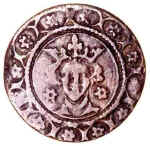
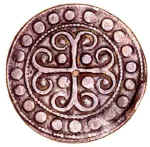
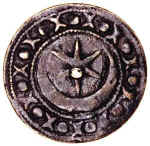
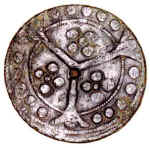
Many varieties, mostly of sterling penny size, are known, always copper or brass, with or without king's effigy. Some pieces can be considerably larger: especially the type with a bust resembling the radiate portrait of the Roman Emperor Postumus (up to 32mm). All English jettons seem to be pierced, either completely or partially. This is the best way of distinguishing between English and French jettons which can be very similar. The last major series of English jettons seems to be late 14th century. A few are known, in silver, for the 15/16th centuries struck for noble households (see Medallic Illustrations of British History). Subsequently they were imported, initially from France, then from Tournai and finally from Nuremberg.
Edward III jetton. Design derived from portrait of the Roman Emperor Postumus. Legend reads 'Le Soudan de Babylon'.
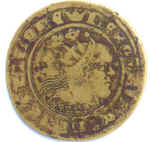
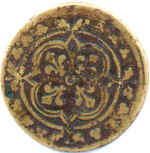
France: the earliest French jettons are claimed to be from the reign of Louis VIII
(1218-
Italy: there is a large, and very varied, series of jettons issued by representatives of the Italian banking houses that took over (in England) the financial functions of the Jews; after their expulsion by Edward 1st in 1290. It was thought that the early adoption of sophisticated accounting techniques meant they were not used in Italy itself, however, several large Italian municipal collections have recently been published. These Italian jettons, probably struck from the very end of the 13th century until the end of the 14th, frequently show monograms or merchants marks; but these are rarely identifiable.
Netherlands: There are several different series of jettons that can be classified under this heading. Jettons were struck in Flanders probably from the 14th century. The jettons from Tournai (now in Belgium) are so commonly found in Britain as to lead one to assume that this area was our prime source of supply in the late 15th and early 16th centuries. The very numerous series of rather medallic looking jettons, most familiar from their depiction of events in the wars between Spain and the United Provinces during the 16th and 17th centuries, started with issues from the Duchy of Burgundy. The cities producing this quite homogeneous series extend from Groningen in the north of the modern Netherlands, through Brussels in modern Belgium, to Lille, now in France: so large were the territories under dispute.
Germany: Although it might seem that Nuremberg was the only German city to strike
jettons, this is far from the case. Although they are not commonly seen in Britain,
jettons may be found from Prussia, Saxony, Bohemia etc. and there is an extensive
series from Hanover. These were issued by the mint-
Nuremberg: This city was the prime source of the jettons used in Britain from the
middle of the 16th century. The earliest seems to be a very extensive series of mostly
small (approx. 20mm) brass counters with an amazing variety of types, including bishop,
horse, monkey, shields, and also the reichapfel or orb which is almost a Nuremberg
trade mark. These early pieces have been found on pre-
Method of use
The abacus, on which the jettons were placed, could vary considerably. It could be a special cloth embroidered with squares or lines, a wooden board rather similar to a shove ha'penny board or just lines marked on a table. It could also vary in size, depending on how many people needed to see the accounts being reckoned: the English Exchequer table being 10' x 5'.
Although there were many ways of laying out the counters, a simple method is illustrated.
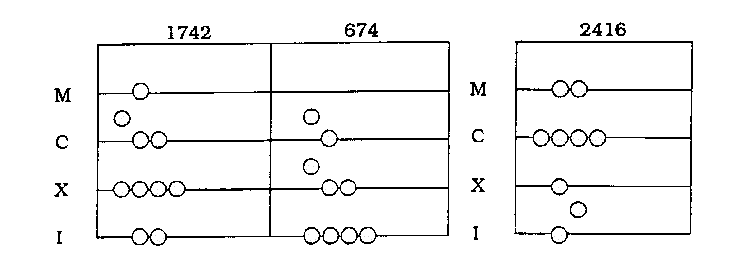
The illustration shows a reckoning board with jettons laid out to perform an addition. The horizontal lines represent units or multiples of ten, the spaces between the lines are used for 5, 50, 500 etc. To represent the first part of the addition (1742) requires 10 jettons:
|
1 |
x |
1 |
0 |
0 |
0 |
|
1 |
x |
|
5 |
0 |
0 |
|
2 |
x |
|
1 |
0 |
0 |
|
4 |
x |
|
|
1 |
0 |
|
2 |
x |
|
|
|
1 |
To represent the second sum to be added (674) requires a further 9 jettons:
|
1 |
x |
5 |
0 |
0 |
|
1 |
x |
1 |
0 |
0 |
|
1 |
x |
|
5 |
0 |
|
2 |
x |
|
1 |
0 |
|
4 |
x |
|
|
4 |
To add the two together the jettons on each line are pushed together, starting from the bottom line, and working upwards. There are two basic rules to be observed: no more than four jettons on a line (i.e. representing 4 or 40 etc) and no more than one jetton between a line (i.e. representing 5 or 50 etc). In the example because we would have 6 jettons on the unit line, we have to take five away and replace them with one in the 5 position. Similarly because there are six jettons on the 10 line we have to replace 5 by one in the 50 position. However we now have 2 x 50 so these are replaced by 1 x 100. When the top line is reached there should be 9 jettons left on the board to represent the total of 2416:
|
2 |
x |
1 |
0 |
0 |
0 |
|
4 |
x |
|
1 |
0 |
0 |
|
1 |
x |
|
|
1 |
0 |
|
1 |
x |
|
|
|
5 |
|
1 |
x |
|
|
|
1 |
The method of subtraction is very similar.
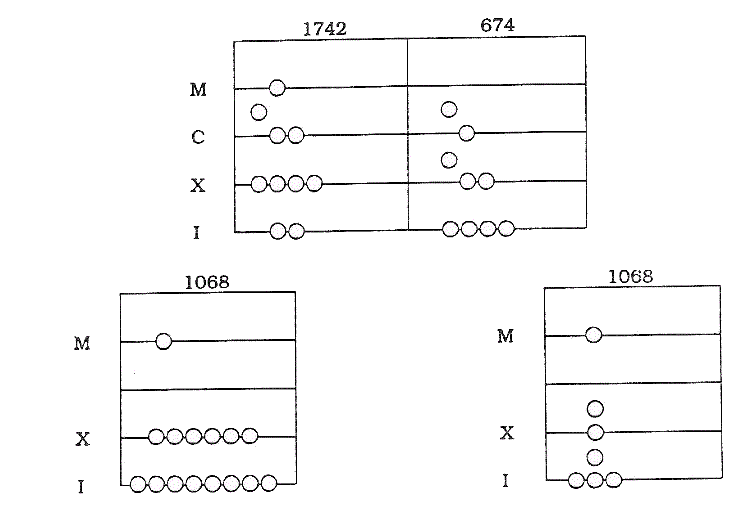
This time we work down from the highest numbers removing jettons as each line is completed.
Hence 1000's no change
500's 1 minus 1 = 0
100's 2 minus 1 = 1
To subtract 70 from 40 take one jetton from the 100 line and add three to the 10 line. Finally to subtract 4 from the smaller number take one from the 10 line and add 6 to the units. On tidying the board to avoid having too many jettons on a line we finish up with the result on the right.
Multiplication could be done either by multiple addition, or by the use of multiplication tables. Division was also possible using jettons, but was even more complicated.
Makers of Nuremberg jettons
|
George Schultes |
1515- |
|
Hans Schultes 1 |
1553- |
|
Hans Schultes 2 |
1586- |
|
Hans Schultes 3 |
1608- |
|
Damianus Krauwinckel |
1543- |
|
Egidius Krauwinckel |
1570- |
|
Hans Krauwinckel 1 |
1562- |
|
Hans Krauwinckel 2 |
1586- |
|
Killianus Koch |
1580- |
|
Wolf Lauffer 1 |
1554- |
|
Hans Lauffer 1 |
1584- |
|
Matheus Lauffer |
1612- |
|
Wolf Lauffer 2 |
1612- |
|
Conrad Lauffer |
1637- |
|
Wolf Lauffer 3 |
1650- |
|
Lazarus Gottleib Lauffer |
1663- |
This list only contains the most frequently seen names. Full details can be found
in "Die Nurnberger Rechenpfennig-
Select Bibliography
|
Barnard F.P. |
The Casting Counter and the Counting Board |
Oxford 1917, reprint Fox, Castle Cary 1981 |
|
|
Berry George |
Medieval English Jettons |
Spink 1974. |
|
|
De la Tour Henri |
Catalogue de la Collection Rouyer |
Paris 1899- |
|
|
Dugniole J.F |
Le Jeton Historique de Pays- |
Brussels 1876- |
reprint available |
|
Eklund O.P |
The Counters of Nuremberg, |
1926 |
reprinted |
|
Feuardent F |
Jetons et Mereau |
Paris 1904- |
reprint available. |
|
Gebert C.F |
Die Nurnberger Rechenpfennigschlager |
Munich 1918 |
reprint available |
|
Labrot Jacques |
Une histoire economique et populaire du Moyen Age |
Paris 1989 |
|
|
Mitchener Michael |
Jetons, Medallets and Tokens Vol. 1 Mediaeval period & Nuremberg |
Seaby 1988 |
|
|
Mitchener Michael |
Jetons, Medallets and Tokens Vol. 2 The Low Countries & France |
1991 |
|
|
Pullan J M. |
The History of the Abacus |
London 1968 |
|
|
Rouyer & Houcher |
Histoire du Jeton au Moyen Age |
Paris 1858 |
reprint available |
|
Snelling Thomas |
A view of Jettons |
London 1769 |
|
|
Van Loon |
Histoire Metallique des dix- |
Hague 1732- |
|